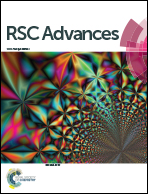A novel preparation of Ag-doped TiO2 nanofibers with enhanced stability of photocatalytic activity†
Abstract
Hierarchical structures with high densities of secondary Ag nanoparticles grown on primary TiO2 fibers have been produced by a facile and low-cost way, by combining electrospinning and hydrothermal techniques. The photocatalysis properties were verified by degradation of Rhodamine B (RhB), and exhibited high efficiency and stability under UV-light illumination.


 Please wait while we load your content...
Please wait while we load your content...